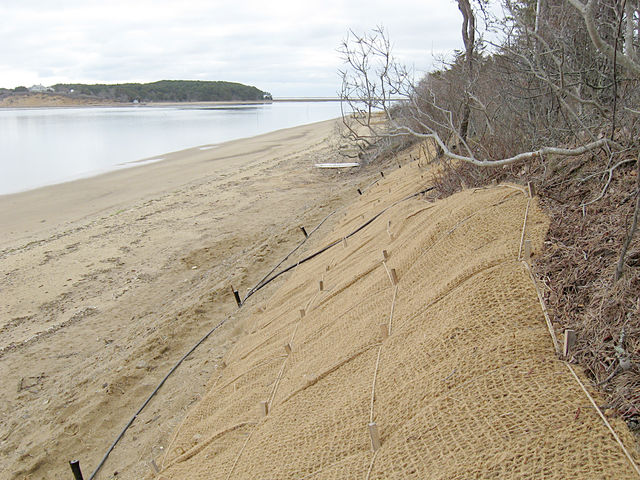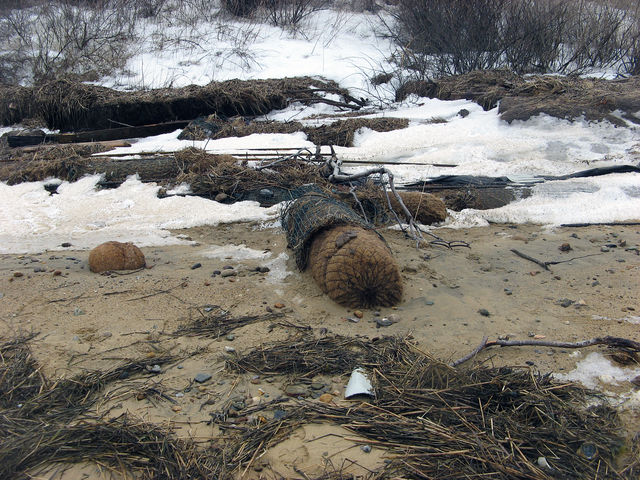

A family residence sits high above the shoreline overlooking the bay. This seaside home has been in the same family for several generations and has undergone renovations and upgrades to the residence and its surrounding property. Despite diligent property maintenance, this coastal home, albeit not immediately, is in jeopardy. The coastal slope at the edge of the property is shrinking in area. It is in constant flux due to erosion caused by tidal cycles and storm surges.
The homeowners of this property are not alone; their neighbors are equally concerned about protecting their properties from the natural cycles that cause the sand to erode at the foot of their coastal bank.
Let's take a look at four adjacent properties where homeowners have taken different approaches toward mitigating the effects of erosion.
Our first snapshot shows a beach area that has a rip rap rock revetment in place to mitigate the effects of erosion. The level of shoreline protection here is strong and has been very effective in protecting the embankment. However, regulations for shoreline protection in this area have changed significantly since the time that this revetment was installed.

Adjacent Rip Rap Rock Revetment
Moving east, the next property is a private residence that was built in approximately 1965. As a property built prior to 1978, the owners have been allowed to install the same level of protection afforded to the previous example. The rock revetment is sturdy and has been effective in keeping soil and vegetation in place since its installation.
Heading further east sits a private residence that was built after 1978, much later than its neighbor to the left. As such, environmental regulations allowed the homeowners to use only a "soft" solution to mitigate erosion. "Soft solution" is a term used to describe a classification of technology used to create coastal bank stabilization. Soft solution erosion protection is considerably less durable than hard, rip-rap erosion protection, but can afford a threatened property some short-term protection against minor storms.
The "soft solution" used is known as a fiber roll stabilization system. A fiber roll is a collection of coconut fibers rolled tightly together and encased in organic netting. Each roll is about two feet in diameter; about ten feet long; and weighs close to 100 pounds. At this property, regulations allowed for a collection of approximately 25 fiber rolls to be installed two feet below beach level and six feet up the slope of the bank. Each roll is encased in metal netting. A metal strap is then placed around each roll and anchored to metal rods embedded in the slope of the bank.

Fiber roll stabilization with anchors.
This soft solution has provided adequate protection for the embankment as evidenced by the vegetation that has remained in place. When fiber rolls stay in place, this solution can be quite effective in erosion mitigation.
About two years ago, the next homeowner to the east received approval to back-fill their eroding coastal bank and to install a fiber roll system. After the fill was in place, a filter fabric, that allows water to come through, but prevents soil from seeping through, was placed up against the slope. Because this house was built around 1990, the homeowners were not permitted to install a metal netting and rod system. The fiber rolls used at this residence were tied to one another with jute - a biodegradable vegetable fiber that is spun into coarse, strong threads. The rolls did not have metal strapping to anchor them to the embankment, but rather a biodegradable twine attached to a duckbill anchor buried in the embankment. The fiber roll systems used in these adjacent properties are similar, but different materials were used at each site in accordance with environmental regulations at the time of installation.

Filter fabric on an embankment.
On a calm day, both systems appear to provide adequate shoreline protection. However, following strong summer storms, this softer solution fiber roll system did not prevail. Most of the fiber rolls washed out to sea or moved so significantly out of place, that they were no longer effective. The fill used to compensate for the eroded slope washed away and vegetation and some oak trees slid down the embankment.

Dislodged fiber rolls.
While the homeowners were discouraged by investing in what turned out to be only a short-term solution, they can see that with no protection at all, the situation could be more dismal as shown in the image below. The next property is faring quite poorly from year to year as there is no coastal bank stabilization system in place.

Note the significant loss of fill, vegetation, and large, mature trees that have fallen out of the eroded bank and now rest on the beach.
So, what is the answer? There is no one ideal system of shoreline stabilization that fits all erosion situations. However, part of the solution is working with the right team of coastal engineers and wetlands specialists who understand the coastal process mechanisms, the environmental regulatory restrictions, and the engineering solutions that can be implemented to protect property values.
Coastal Engineering Co., Inc. has more than 40 years of experience with shorefront protection and will be happy to consult with you to select the best scenario for your property. Contact us to get started!